全球首次完成杨树全基因组测序
杨树KT、HAK、KUP基因家族鉴定及钾肥处理对杨树生长的影响

第52卷第2期东㊀北㊀林㊀业㊀大㊀学㊀学㊀报Vol.52No.22024年2月JOURNALOFNORTHEASTFORESTRYUNIVERSITYFeb.20241)中央高校基本科研业务费专项资金项目(2452023021)㊂第一作者简介:安伟,男,2001年2月生,西北农林科技大学林学院,本科生㊂E-mail:Anwei0214@126.com㊂通信作者:张玲玲,西北农林科技大学林学院,实验师㊂E-mail:zl524@sina.cn㊂收稿日期:2023年8月15日㊂责任编辑:潘㊀华㊂杨树KT㊁HAK㊁KUP基因家族鉴定及钾肥处理对杨树生长的影响1)安伟㊀张玲玲(西北农林科技大学,杨凌,712100)㊀㊀摘㊀要㊀KT㊁HAK㊁KUP基因家族是植物进行K+转运的最大蛋白系统㊂以毛果杨(PopulustrichocarpaTorr.&Gray)全基因组数据为基础,利用生物信息学方法对杨树KT㊁HAK㊁KUP家族进行了全基因组鉴定,并在毛果杨全基因组中鉴定出20个KT㊁HAK㊁KUP家族成员㊂理化性质预测分析表明:KT㊁HAK㊁KUP基因家族成员均为疏水性蛋白,等电点在5.30 9.16;亚细胞定位预测显示家族成员蛋白集中在细胞质膜上㊂应用拟南芥和杨树构建系统进化树显示,KT㊁HAK㊁KUP基因家族可分为5个亚家族㊂基因结构及基序(motif)分析表明,KT㊁HAK㊁KUP基因进化过程相对保守㊂顺式作用元件分析表明,KT㊁HAK㊁KUP基因家族成员含有诸多与激素㊁逆境胁迫的响应元件㊂杨树不同钾离子浓度处理下,植株的净生长情况呈现了显著的差异,说明钾元素对杨树生长影响较大㊂关键词㊀钾转运蛋白;杨树;钾分类号㊀S718.46IdentificationofKT㊁HAK㊁KUPgenefamilyinPopulusanditseffectongrowthunderpotassiumfertilizertreat⁃ment//AnWei,ZhangLingling(NorthwestA&FUniversity,Yangling712100,P.R.China)//JournalofNortheastFor⁃estryUniversity,2024,52(2):1-8.TheKT㊁HAK㊁KUPgenefamilyisthelargestproteinsystemsforK+transportinplants.BasedonthewholegenomedataofPopulustricocarpaTorr.&Gray,theKT㊁HAK㊁KUPgenefamilyinpoplarwasidentifiedusingbioinformaticsmeth⁃ods,and20membersoftheKT㊁HAK㊁KUPgenefamilywereidentifiedintheP.tricocarpagenome.Thepredictionanda⁃nalysisofitsphysicochemicalpropertiesshowedthatmembersoftheKT㊁HAK㊁KUPgenefamilyarehydrophobicproteinswiththeisoelectricpointrangingfrom5.30to9.16.Subcellularlocalizationpredictionshowedthattheproteinsofthefamilyaremainlylocatedonthecytoplasmicmembrane.PhylogeneticanalysisbasedonArabidopsisthalianaandpopulusconstruc⁃tedasystematicevolutionarytree,whichshowedthattheKT㊁HAK㊁KUPgenefamilycanbedividedinto5subfamilies.GenestructureandmotifanalysisshowedthattheevolutionoftheKT㊁HAK㊁KUPgenefamilyisrelativelyconserved.Cis⁃actingelementanalysisshowedthatmembersoftheKT㊁HAK㊁KUPgenefamilycontainmanyresponseelementsrelatedtohormonesandstress.Thenetgrowthofplantsshowedsignificantdifferencesunderdifferentpotassiumionconcentrations,indicatingthatpotassiumhasasignificantimpactonpoplargrowth.Keywords㊀Potassiumtransporterprotein;Populus;Potassium㊀㊀钾元素是植物生长发育过程中必不可少的矿质元素之一,在植物生长发育过程起着重大作用㊂钾参与植物体内许多重要的生理生化过程,如促进植物基础生理代谢㊁调节气孔运动,促进光合作用㊁维持阴阳离子平衡㊁调节渗透压等[1],对植物整个生命周期至关重要㊂此外,钾元素在植物盐胁迫适应㊁耐干旱胁迫㊁有机酸物质长距离运输㊁氮素利用㊁糖分累积方面都发挥了重要作用[2-3]㊂钾缺乏则会导致植物老叶加速黄化,根系短小且易倒伏[4]㊂植物吸收钾离子主要依靠钾转运蛋白和钾离子通道㊂目前研究表明,参与植物体内K+吸收及转运的蛋白或通道共有5类:KT㊁HAK㊁KUP家族转运蛋白㊁HKT家族转运蛋白㊁CPAs家族转运蛋白㊁Shaker通道和TPK通道[5]㊂其中,KT㊁HAK㊁KUP家族是一类数量众多的基因家族,广泛分布于细菌㊁真菌和植物中[6]㊂目前从拟南芥(Arabidopsisthaliana)鉴定出13个KT㊁HAK㊁KUP相关家族基因[7],水稻(Oryzasativa)中27个基因[8],紫柳(Salixpurpurea)中22个基因[9],玉米(Zeamays)27个基因[10],番茄(So⁃lanumlycopersicum)19个基因[11],茶树(Camelliasinensis)21个[12],钾转运蛋白在不同物种中有较为广泛的分布,但也存在较大的功能分异㊂KT㊁HAK㊁KUP家族分为5个亚族,亚族Ⅰ主要包括拟南芥AtHAK5㊁水稻OsHAK5等;亚族Ⅱ主要包括拟南芥AtKUP1㊁AtKUP2等;亚族Ⅲ主要包括拟南芥AtKUP9㊁AtKUP10等;亚族Ⅳ主要包括水稻Os⁃HAK4和OsHAK17;亚族Ⅴ主要包括AtKUP5㊁AtK⁃UP7等[13]㊂亚族Ⅱ和亚族Ⅲ的成员在双子叶和单子叶植物中的分布相似,表现出很强的保守性㊂亚族Ⅰ和Ⅳ的成员则与之相反,在多种双子叶植物如拟南芥(Arabidopsisthaliana)㊁葡萄(Vitisvinifera)㊁蒺藜苜蓿(Medicagotruncatula)和单子叶植物如水稻㊁玉米和短柄草(Brachypodiumsylvaticum)中都有所体现[14-16]㊂KT㊁HAK㊁KUP转运体家族成员定位在植物不同细胞器的膜上,如质膜㊁液泡膜和类囊体膜[17-18]㊂同一簇的家族成员细胞定位也并不相同,因而可能发挥不同的细胞生物学功能㊂如簇Ⅱ成员AtKUP4定位于液泡膜,OsHAK2定位于细胞质膜,而OsHAK10定位于液泡膜等㊂在盐胁迫条件下,水稻中的高亲和性K+转运体OsHAK1㊁OsHAK5和Os⁃HAK21在转运K+方面表现出不同的能力㊂这种差异不仅与它们所处的细胞位置有关,还与它们在不同组织中的表达特异性以及根细胞膜电位的变化相关㊂目前K+转运蛋白功能研究主要集中在拟南芥㊁水稻中,杨树中的研究还有待进一步深入㊂杨树分布广泛,速生㊁抗逆性强,是我国最为重要的用材树种,西北杨2号(Populusalba✕P.tomen⁃tosa Xibeiyang2 )为西北农林科技大学新培育的杨树速生优质新品种,可广泛应用于北方杨树造林㊂在杨树优质大径材培育中钾元素的缺乏是影响其速生丰产的关键因素之一㊂KT㊁HAK㊁KUP家族是植物吸收和转运钾的关键蛋白家族,影响植物生长发育和抗逆能力,对杨树产量性状形成起到重要的调控作用㊂基于此,本研究以毛果杨的基因组数据库为基础,结合生物信息学方法鉴定杨树KT㊁HAK㊁KUP基因,同时对该家族成员开展理化性质分析,构建系统进化树㊁染色体定位,开展基因结构㊁保守基序分析;结合实时荧光定量PCR方法分析杨树KT㊁HAK㊁KUP基因在不同钾肥(KCl)浓度处理下表达情况㊂研究KT㊁HAK㊁KUP基因家族在杨树中的分类与表达不仅可以帮助我们更好地了解这些基因在杨树生长发育调控中的功能和作用,而且可以为今后杨树改良和高效钾吸收的杨树品种筛选鉴定提供理论基础㊂1㊀材料与方法试验所用杨树材料为西北农林科技大学渭河实验站西北杨2号无性系㊂于西北农林科技大学科研温室利用水培法培养1年生扦插苗,选取长势均匀一致的扦插苗分成4组,分别使用含有0.1㊁0.5㊁1.0㊁3.0mmol/LKCl的Hoagland溶液浇灌,每4d更换1次营养液,45d后测定各处理杨树株高㊂杨树KT㊁HAK㊁KUP基因家族的全基因组鉴定㊂Phytozome(https://phytozome-next.jgi.doe.gov/)在线数据库下载毛果杨基因组fa文件,注释gff文件及蛋白质protein文件,利用TBlools工具提取杨树基因组的CDS序列,参数设置为Parent㊂从Pfam(http://pfam.xfam.org/)数据库下载HAK蛋白特征结构域K-Trans(PF02705)的隐马尔可夫模型[19],利用HMMER软件在比对的假阳性预期值E<1ˑ10-5条件下进行杨树KT㊁HAK㊁KUP基因家族成员初步筛选㊂将筛选得到的数据在CD-HIT中进一步处理㊂去除重复成员㊂最后使用CCD(https://www.ncbi.nlm.nih.gov/cdd)进行蛋白结构域验证㊂杨树KT㊁HAK㊁KUP基因家族理化性质㊂使用ExPASy在线网站(http://www.expasy.org)查找获得杨树KT㊁HAK㊁KUP基因的相对分子质量㊁氨基酸数量㊁不稳定系数等理化性质㊂通过WoLFPSORT网站(https://wolfpsort.hgc.jp/)对杨树KT㊁HAK㊁KUP基因进行亚细胞定位预测㊂杨树KT㊁HAK㊁KUP基因系统进化树㊂在拟南芥数据库(https://www.arabidopsis.org/)获取KT㊁HAK㊁KUP基因家族成员信息㊂利用ClustalX2对杨树和拟南芥KT㊁HAK㊁KUP蛋白进行氨基酸多序列比对㊂使用MEGA11软件运用比邻法获得最优进化模型,构建系统发育进化树,默认参数为1000次Bootstrap重复㊂利用ITOL(https://itol.embl.de/)对进化树进行美化㊂杨树KT㊁HAK㊁KUP基因家族染色体定位及共线性㊂利用TBtools工具对鉴定筛选出的杨树KT㊁HAK㊁KUP家族基因进行染色体定位,并根据各基因在染色体上位置顺序的比较结果,对预测的KT㊁HAK㊁KUP基因进行命名㊂利用多重共线性扫描工具包(MCseanx)分析杨树与簸箕柳之间共线性关系㊂杨树KT㊁HAK㊁KUP基因家族基因结构与保守基序㊂采用在线软件GSDS(http://gsds.cbi.pku.edu.cn/)㊁MEME(http://meme-suite.org/tools/meme)分别分析该家族成员基因结构和编码蛋白保守基序[20](基数参数为15,其余为默认),并用TBtools进行展示㊂杨树KT㊁HAK㊁KUP基因家族顺式作用元件㊂提取鉴定筛选出的杨树KT㊁HAK㊁KUP基因上游2000bp的CDS序列提交至PlantCARE在线网站进行顺式元件作用分析[21]㊂1.1㊀光响应曲线测定在杨树不同K+浓度处理15d时,于09:00 12:00,使用便携式光合仪LI-6400XT(LI-COR,美国)采用自动可调人工光源,分别测定自然CO2摩尔分数(380μmol㊃mol-1)下,光合有效辐射为0㊁20㊁50㊁100㊁200㊁400㊁600㊁800㊁1000㊁1200㊁1400㊁1600㊁1800μmol/(m2㊃s)时杨树叶的光强-光合响应曲线㊂利用光合响应曲线分析计算光饱和时最大2㊀㊀㊀㊀㊀㊀㊀㊀㊀㊀东㊀北㊀林㊀业㊀大㊀学㊀学㊀报㊀㊀㊀㊀㊀㊀㊀㊀㊀㊀㊀㊀㊀㊀㊀㊀第52卷净光合速率(Pnmax)㊁暗呼吸速率(Rd)㊂1.2㊀根叶RNA提取与反转录采集不同K+浓度处理后1㊁5㊁15d时的叶㊁根样品,采用OmegaRNA提取试剂盒提取根叶的RNA㊂采用EasyScriptOne-StepgDNARemovalandcDNASynthesisSuperMix试剂盒反转录RNA获得cDNA用于qRT-PCR㊂1.3㊀荧光定量分析使用软件PrimerPrimer5对杨树PTHAKs基因进行cDNA特异性引物设计,设计扩增产物长度150 250bp,退火温度Tm值为55ħ,引物信息如表1㊂以Actin为内参基因,2ˑSybrGreenqPCRMix荧光定量试剂进行荧光定量试验㊂qRT-PCR反应体系25μL,包括2ˑSybrGreenqPCRMix12.5μL㊁cD⁃NA模板1.0μL㊁正反向引物各0.5μL㊁双蒸水10.5μL㊂PCR程序:94ħ预变性2min㊁90ħ变性20s㊁55ħ退火20s㊁72ħ延伸30s㊁40个循环㊂使用2-ΔΔCt法[22]计算PTHAKs相对表达量㊂表1㊀PTHAKs实时荧光定量引物信息基因引物序列(5 -3 )基因引物序列(5 -3 )PTHAK1-FGAACTTCTCCGCTTTACGTATATGCPTHAK11-FCTGCCGACACTCCAGAATGGPTHAK1-RTTAAGCATAGGCACCAGCACAATPTHAK11-RAAACAACACGCGAACTACGATGPTHAK2-FTTTCAAAGCDTTGGAGTACTTTATGPTHAK12-FACCACCGCCTACTACTACCACTACTPTHAK2-RTGGGCACGAGCACTATGGTATPTHAK12-RACAAGCCCTCCGAAGACAACTPTHAK3-FGTAGTGATGTAGTCGTGCTTGTTGCTPTHAK13-FGTTCCAGGAATCGGACTGCTGPTHAK3-RCAAAGAGCCAACTAACCCTATCCACPTHAK13-RAGTCCTTCGGACAAACTCTACGGPTHAK4-FGCACGGCGGTGGATTAGAATPTHAK14-FCCAAATCAACAAGCCACAGATGPTHAK4-RCATCGAAGGAGTCGATGAGGGPTHAK14-RCCAATTGCCATACACGTCCCPTHAK5-FGTCTTCCTCATTGCTAACTTAGCTGCPTHAK15-FGGTGCAAGGGATGAGATGGAGAPTHAK5-RGAGCAGACAAACACCAAGCAAACTAPTHAK15-RCAACTCTGAGGTGCCTGCTGACTPTHAK6-FTCTGATCCAGGCAAAGGAAGCAPTHAK16-FCACTCAATCCAGCCTACATCTATTTCPTHAK6-RCAATTCTTCCGAAGAAATGAATACCCPTHAK16-RCTGTAATGCACAGAACGCAACCPTHAK7-FCTTGTCCTTGTTGGCACTTGTATGPTHAK17-FTGATTGGACGAAATGCTCCTGTPTHAK7-RTGCAACAACTATGACTACATCGCTACTPTHAK17-RCGAACTGTTAAATGCGACTGACCPTHAK8-FATAACAGGGACGGAAGCCCTCTPTHAK18-FGGGATGGTGTCCTCACTCCTTPTHAK8-RGCTGACAGAAGGCACGGAAATACPTHAK18-RCCAAACGATGCTATCTTGGGTPTHAK9-FGATAATGGCGAAGGAGGGATTTPTHAK19-FGATTGATGCCAGGGAAAGTGGPTHAK9-RTGGAAATTGCAGGCGTGAAGPTHAK19-RGTTCAATGCCACTGGAGGTTCTPTHAK10-FCGGAGGTGAACTGGATGTAGATGGPTHAK20-FCTGATGATGAGTCCGTAACCCTCPTHAK10-RGCCAGGCAAGAAGACAAGTAGAGCPTHAK20-RGCTTGAACATGCGAGTGTCCTAACT-FCGGTGTGATGGTTGGTATACT-RATCATCCCAATTGCTAACA2㊀结果与分析2.1㊀杨树KT㊁HAK㊁KUP基因家族通过对毛果杨基因组的筛选与鉴定,共获得20个PTHAK家族成员,根据基因在染色体上的位置信息依次命名为PTHAK1 PTHAK20㊂蛋白基本理化性质分析结果表明(表2):PTHAKs长度介于610 860个氨基酸,蛋白分子质量介于67065.88 95442.98u,平均分子质量为86424.98u㊂等电点介于5.30 9.16,75%成员的等电点处于碱性区间,表明大部分PTHAK蛋白含碱性氨基酸数量多㊂不稳定系数介于32.59 45.49,其中14个PTHAKs成员为稳定性蛋白,6个成员为不稳定性蛋白㊂所有PTHAKs蛋白成员都属于疏水性蛋白㊂根据亚细胞定位预测结果显示,PTHAKs主要位于细胞质膜上,这和PTHAKs负责钾元素转运的作用密切相关㊂2.2㊀杨树KT㊁HAK㊁KUP蛋白序列系统进化树将13个拟南芥AtHAKs㊁20个杨树PTHAKs成员蛋白序列进行多重序列比对和系统进化树构建㊂结果(图1)显示杨树20个HAKs家族成员被分为5个亚家族,其中PTHAK1㊁PTHAK2㊁PTHAK18属于第Ⅰ家族,PTHAK17㊁PTHAK19㊁PTHAK20㊁PTHAK15分属于第Ⅱ亚家族,PTHAK8㊁PTHAK3㊁PTHAK7分属第Ⅲ亚家族,PTHAK12㊁PTHAK10㊁PTHAK11等6个成员分属第Ⅳ亚家族,其余4个成员分属第Ⅴ亚族㊂2.3㊀杨树KT㊁HAK㊁KUP基因家族染色体定位及共线性杨树PTHAKs基因家族成员的染色体定位结果(图2)表明:20个PTHAKs基因成员不均匀分布在1㊁2㊁3㊁5号等10条毛果杨染色体上㊂其中:5号染色体上分布最多,有5个成员;3号染色体有4个成员;8㊁10号染色体上均有2个PTHAKs成员;2㊁5㊁9㊁3第2期㊀㊀㊀㊀㊀㊀㊀㊀㊀㊀安伟,等:杨树KT㊁HAK㊁KUP基因家族鉴定及钾肥处理对杨树生长的影响12㊁14㊁15㊁19号染色体均只有1个PTHAK成员㊂利用簸箕柳和杨树进一步分析种间共线性关系(图3),杨树与簸箕柳构成20对共线性关系,分别位于1㊁2㊁3㊁8㊁9㊁10㊁12㊁14㊁15㊁19号染色体上㊂图1㊀拟南芥和杨树KT㊁HAK㊁KUP基因家族系统进化树2.4㊀杨树KT㊁HAK㊁KUP基因家族基因结构与保守基序根据基因结构分析(图4):PTHAKs外显子数7 10个不等,以8个居多㊂其中第Ⅳ㊁Ⅱ亚家族PTHAK11和PTHAK19具有9个外显子,PTHAK15和PTHAK20具有7个外显子;第Ⅴ亚家族PTHAK5具有10个外显子,PTHAK4㊁PTHAK16㊁PTHAK13具有9个外显子㊂使用MEME对PTHAKs家族保守基序分析(图5),获得15种基序(motif),命名为motif1 motif15㊂其中PTHAK12无motif14㊁motif15,PTHAK11无mo⁃tif14,PTHAK19无motif13;PTHAK4无motif13㊁mo⁃tif1,PTHAK13无motif14㊁motif7㊁motif15㊁motif12㊁motif11,PTHAK2无motif12㊁motif11,其余成员均有15种基序㊂图2㊀杨树PTHAKs基因家族染色体分布灰色区域是毛果杨与簸箕柳基因组间共线性,红色区域代表HAKs基因位置㊂图3㊀毛果杨与簸箕柳共线性表2㊀杨树PTHAKs成员理化性质基因ID基因名称所在染色体位置长度分子质量/u等电点不稳定系数亲水性亚细胞定位Potri.001G045200.1PTHAK1Chr01:32789683284000(+)821.0091846.608.5932.590.18质膜Potri.001G069799.1PTHAK2Chr01:52644965272165(+)689.0077269.388.4233.500.33质膜Potri.001G123700.1PTHAK3Chr01:1016169510167970(-)791.0088173.107.8837.900.35质膜Potri.001G205500.4PTHAK4Chr01:2091493320922937(-)775.0086136.785.3038.680.21质膜Potri.001G205500.1PTHAK5Chr01:2091486520922967(-)860.0095442.985.5638.440.29质膜Potri.002G237500.3PTHAK6Chr02:2299688823002575(-)833.0092731.449.0643.780.51质膜Potri.003G109700.1PTHAK7Chr03:1321049613217001(+)798.0089669.688.6436.400.31质膜4㊀㊀㊀㊀㊀㊀㊀㊀㊀㊀东㊀北㊀林㊀业㊀大㊀学㊀学㊀报㊀㊀㊀㊀㊀㊀㊀㊀㊀㊀㊀㊀㊀㊀㊀㊀第52卷续(表2)基因ID基因名称所在染色体位置长度分子质量/u等电点不稳定系数亲水性亚细胞定位Potri.003G109800.3PTHAK8Chr03:1321973613224424(+)790.0088302.146.8535.290.39质膜Potri.003G133900.1PTHAK9Chr03:1519858315204501(-)776.0087203.289.1644.420.39质膜Potri.003G148200.1PTHAK10Chr03:1621528916220681(-)746.0083188.318.4636.070.43质膜Potri.005G095900.1PTHAK11Chr05:67693076779647(+)723.0080118.158.1340.370.55质膜Potri.008G140800.1PTHAK12Chr08:94992049504880(-)760.0083882.787.8945.490.33质膜Potri.008G147300.3PTHAK13Chr08:1003557010041548(+)610.0067065.887.5232.800.57质膜Potri.009G073500.1PTHAK14Chr09:71977167203158(+)761.0084557.058.2933.980.41质膜Potri.010G094300.1PTHAK15Chr10:1183700911842902(-)780.0087473.558.3136.020.34质膜Potri.010G094400.1PTHAK16Chr10:1184736911853805(-)847.0093612.995.9541.730.35质膜Potri.012G043501.1PTHAK17Chr12:38987683915101(-)789.0088395.728.3139.480.25质膜Potri.014G132500.1PTHAK18Chr14:88590878864640(+)774.0086802.328.4132.910.20质膜Potri.015G034200.1PTHAK19Chr15:28219462827893(-)790.0088784.488.6037.030.26质膜Potri.019G056500.10PTHAK20Chr19:95191739526682(-)793.0087843.326.7340.350.39质膜图4㊀PTHAKs基因结构2.5杨树KT㊁HAK㊁KUP基因家族顺式作用元件获取杨树KT㊁HAK㊁KUP基因家族启动子上游2000bp区域,分析启动子区域发现杨树KT㊁HAK㊁KUP基因家族均存在TATA-box㊁CAAT-box㊁厌氧诱导㊁光信号响应的顺式元件㊂此外,80%的成员包含赤霉素响应元件,70%的成员有脱落酸响应元件,75%的成员包含干旱诱导的MYB结合元件,45%的成员包含生长素响应等元件(图6)㊂2.6㊀杨树植株高生长测定为了探究K+对杨树生长的影响,使用不同钾素浓度处理西北杨2号无性系,测定植株高生长状况㊂表3中记录了在0.1㊁0.5㊁1.0㊁3.0mmol/LKCl处理下杨树的净生长数据,4个浓度钾素处理下树高生长斜率分别是2.04㊁2.82㊁3.03㊁2.91,表明K+是影响杨树生长的限制因素㊂缺钾(0.1mmol/LKCl)条件下,杨树的生长显著低于正常和高钾处理,表明钾素合理施用能够有效提高杨树的高生长㊂图5㊀PTHAKs保守基序表3㊀不同钾素浓度时杨树净生长值检测次数杨树净生长值/cm0.1mmol/LKCl0.5mmol/LKCl1.0mmol/LKCl3.0mmol/LKCl10㊀㊀㊀㊀0㊀㊀㊀㊀0㊀㊀㊀㊀0㊀㊀㊀㊀2(2.83ʃ0.31)Be(2.88ʃ1.33)Be(6.20ʃ2.44)Ae(4.53ʃ0.70)ABf3(4.57ʃ0.67)Ade(6.00ʃ2.35)ABd(9.00ʃ3.30)Ade(7.40ʃ1.25)ABe4(6.47ʃ0.96)Ad(7.65ʃ1.44)ABd(11.37ʃ3.93)Acde(9.10ʃ1.00)ABe5(7.70ʃ0.79)Bcd(10.50ʃ1.94)ABc(14.03ʃ3.45)Acd(12.03ʃ1.27)Ad6(10.57ʃ1.59)Bbc(13.73ʃ1.50)ABc(16.73ʃ2.66)Abc(14.87ʃ1.50)Ac7(12.67ʃ2.49)Bab(17.17ʃ1.42)Ab(20.27ʃ2.95)Aab(18.47ʃ2.00)Ab8(14.73ʃ3.50)Ba(19.93ʃ0.22)Aa(22.60ʃ2.18)Aa(21.30ʃ1.51)Aa斜率k值2.042.823.032.91㊀㊀注:表中记录8次测定数据,每5d测定1次,第1次净生长计为0;数据为平均值ʃ标准差(n=3);试验为3次重复取平均值结果;同行不同大写字母表示同一时间不同钾素处理差异显著(P<0.05);同列不同小写字母表示同一钾素处理不同时间差异显著(P<0.05)㊂2.7㊀光响应曲线由图7可知4个不同钾素浓度处理下,净光合速率随光合有效辐射增加的变化趋势是相似的,在5第2期㊀㊀㊀㊀㊀㊀㊀㊀㊀㊀安伟,等:杨树KT㊁HAK㊁KUP基因家族鉴定及钾肥处理对杨树生长的影响光合有效辐射(RPA)为0 1000μmol/(m2㊃s),净光合速率(Pn)随RPA增加而快速增加,在1000μmol/(m2㊃s)以上,净光合速率增长趋于平缓㊂1.0和3.0mmol/LKCl处理下,净光合速率最大值高于其他处理,说明不同K+浓度处理对植物的光合作用有重大影响㊂图6㊀PTHAKs成员启动子区顺式元件种类2.8㊀KT㊁HAK㊁KUP基因相对表达通过对杨树KT㊁HAK㊁KUP基因家族表达模式分析(图8)发现,在叶片中PTHAK3㊁PTHAK15在所有钾浓度处理中都有相对较高的表达丰度㊂PTHAK10㊁PTHAK13㊁PTHAK19在低钾(0.1㊁0.5mmol/LKCl)处理下出现相对较高表达情况㊂PTHAK5㊁PTHAK6㊁PTHAK7则是在高浓度钾(1.0㊁3.0mmol/LKCl)处理中有相对较高丰度表达㊂在根系组织中PTHAK3㊁PTHAK6㊁PTHAK15在所有钾浓度中均有较高的表达丰度㊂PTHAK3㊁PTHAK5㊁PTHAK7㊁PTHAK13㊁PTHAK19等成员在低钾胁迫下相对表达量最高㊂PTHAK6㊁PTHAK5㊁PTHAK7㊁PTHAK12㊁PTHAK15则是在高浓度钾(1.0㊁3.0mmol/LKCl)处理中存在较高丰度表达㊂以上结果表明不同PTHAKs家族成员在叶片和根系中的响应存在表达特异性㊂图7㊀杨树4种钾浓度处理光响应特征6㊀㊀㊀㊀㊀㊀㊀㊀㊀㊀东㊀北㊀林㊀业㊀大㊀学㊀学㊀报㊀㊀㊀㊀㊀㊀㊀㊀㊀㊀㊀㊀㊀㊀㊀㊀第52卷图8㊀杨树KT㊁HAK㊁KUP家族成员不同钾素浓度处理下表达模式3 讨论与结论杨树生长速度快,材积产出高,抗逆性较强是我国重要的防护林和工业用材林㊂培育大径级杨树是目前我国杨树生产的重要目标㊂钾元素是植物生长发育过程中必不可少的矿质元素,能够促进植物基础生理代谢,促进光合作用,增强植物逆境抗性等,对杨树大径级材生产起着关键作用㊂开展杨树钾响应以及钾转运调控研究对今后杨树开展丰产栽培㊁杨树遗传改良具有重要意义㊂本研究从毛果杨全基因组数据为基础,利用生物信息学方法对杨树KT㊁HAK㊁KUP家族进行了全基因组学鉴定与生物信息学分析,同时以国审新品种西北杨2号为材料分析了杨树对钾素的生长响应㊂研究在毛果杨全基因组中鉴定出来20个KT㊁HAK㊁KUP家族成员㊂预测分析其理化性质发现,KT㊁HAK㊁KUP基因蛋白序列长度在610 860个氨基酸,平均蛋白序列长度为775个氨基酸;等电点在5.30 9.16,75%成员都属于碱性蛋白;亲水性显示该家族成员都为疏水性蛋白;预测亚细胞定位集中在细胞质膜上,研究结果印证家族基因钾转运蛋白基本特征㊂构建拟南芥和杨树KT㊁HAK㊁KUP基因家族的系统进化树,通过分析可知和拟南芥不同,杨树KT㊁HAK㊁KUP基因家族可分为5个亚家族,这与多数HAK家族被划分为5个系统进化簇类似㊂基因结构及motif的分析表明,KT㊁HAK㊁KUP基因进化过程相对保守,几乎所有成员都包含motif1-mo⁃tif15,这与前人的研究结果一致[23]㊂顺式作用元件分析结果显示,KT㊁HAK㊁KUP基因家族成员含有许多与激素㊁逆境胁迫的响应元件,表明其还可能受到环境胁迫以及植物激素的调控与响应[24]㊂设置了0.1㊁0.5㊁1.0㊁3.0mmol/L4个钾肥(KCl)施用浓度处理来分析杨树的生长情况㊂在对杨树扦插苗净生长测定分析发现,低钾浓度处理显著抑制了杨树无性苗的高生长,说明钾元素直接影响杨树的高生长;同时对不同钾素浓度处理的杨树进行了光响应测定,分析可知在正常(1.0mmol/L)和高钾(3.0mmol/L)处理下,净光合速率最大值均高于低钾处理,说明不同K+浓度处理对杨树的光合作用有重大影响,而提高光合速率是实现杨树大径材培育的重要方式㊂使用实时荧光定量技术检测部分KT㊁HAK㊁KUP家族基因在杨树根和叶中的表达情况㊂研究表明在低钾胁迫下PTHAK10㊁PTHAK13㊁PTHAK15等成员在叶片中有较高表达;PTHAK5㊁PTHAK6㊁PTHAK7等成员在根系中有较高表达㊂在拟南芥的研究发现,缺钾可以诱导AtHAK5的表达,在钾离子浓度小于50μmol㊃L-1时AtHAK5突变体种子萌发缓慢,根生长受抑制,钾离子吸收能力降低[25]㊂另外在拟南芥中发现AtKUP4在根尖表达,通过改变生长素运输来影响根尖的生长[26]㊂同样在水稻中OsHAK5受缺钾和干旱胁迫诱导[27]㊂马铃薯在低钾胁迫下,多数HAK基因表达量呈上调[28],表明马铃薯HAK基因具有低钾响应特征,可能和低钾环境下7第2期㊀㊀㊀㊀㊀㊀㊀㊀㊀㊀安伟,等:杨树KT㊁HAK㊁KUP基因家族鉴定及钾肥处理对杨树生长的影响钾素高效转运相关㊂杨树中多个低钾高表达基因可能在杨树低钾条件下钾素的高效转运相关㊂另外,本研究中使用不同浓度KCl溶液进行钾元素含量的控制,不能忽略的是随着K+浓度的改变,Cl-浓度也随之变化㊂氯作为植物生长必须的营养元素,Cl-也是细胞维持渗透压的主要离子,对细胞延长,维持细胞液缓冲体系㊁水分平衡㊁提高植物抗旱性具有重要意义[29],而具体Cl-的作用还有待今后深入探讨㊂本研究在毛果杨全基因组中鉴定出20个KT㊁HAK㊁KUP家族成员㊂随后对家族成员进行理化性质与亚细胞定位预测分析,构建系统进化树,开展了顺式作用元件分析,最后对4个K+浓度处理杨树扦插苗的净生长与组织基因表达进行分析㊂研究为更好地了解杨树KT㊁HAK㊁KUP基因家族的功能提供了前期基础,同时也为研究和选育高效钾吸收的杨树品种提供了参考信息㊂参㊀考㊀文㊀献[1]㊀WANGY,WUWH.PlantsensingandsignalinginresponsetoK+deficiency[J].MolecularPlant,2010,3(2):280-287.[2]㊀WANGY,WUWH.Regulationofpotassiumtransportandsigna⁃linginplants[J].CurrentOpinioninPlantBiology,2017,39:123-128.doi:10.1016/j.pbi.2017.06.006.[3]㊀柴薇薇,王文颖,崔彦农,等.植物钾转运蛋白KUP/HAK/KT家族研究进展[J].植物生理学报,2019,55(12):1747-1761.[4]㊀谭志新,谢留伟,李洪戈,等.基于AHP-隶属函数法的棉花子叶期耐低钾能力鉴定[J/OL].作物学报.[2023-07-24].ht⁃tp://kns.cnki.net/kcms/detail/11.1809.S.20230721.1723.006.html.[5]㊀WANGY,WUWH.Potassiumtransportandsignalinginhigherplants[J].AnnualReviewofPlantBiology,2013,64:451-476.doi:10.1146/annurev-arplant-050312-12015.[6]㊀吴胜男,杨媛,李英壮,等.小麦KUP/HAK/KT基因家族的全基因组鉴定㊁系统进化和表达模式分析[J].西北农业学报,2021,30(3):351-364.[7]㊀QUINTEROFJ,BLATTMR.AnewfamilyofK+transportersfromArabidopsisthatareconservedacrossphyla[J].FEBSLet⁃ters,2013,415(2):206-211.[8]㊀YANGZF,GAOQS,SUNCS,etal.MolecularevolutionandfunctionaldivergenceofHAKpotassiumtransportergenefamilyinrice(OryzasativaL.)[J].JournalofGeneticsandGenomics,2009,36(3):161-172.[9]㊀LIANGMX,GAOYC,MAOTT,etal.CharacterizationandexpressionofKT㊁HAK㊁KUPtransporterfamilygenesinwillowun⁃derpotassiumdeficiency,drought,andsaltstresses[J].BioMe⁃dResearchInternational,2020:1-12.doi:10.1155/2020/2690760.[10]㊀ZHANGZB,ZHANGJW,CHENYJ,etal.Genome⁃widea⁃nalysisandidentificationofHAKpotassiumtransportergenefami⁃lyinmaize(ZeamaysL.)[J].MolecularBiologyReports,2012,39(8):8465-8473.[11]㊀HYUNTK,YEONGGILR,EKYUNEK,etal.Genome⁃wideandmolecularevolutionanalysesoftheKT㊁HAK㊁KUPfamilyintomato(SolanumlycopersicumL.)[J].GenesGenomics,2014,36(3):365-374.[12]㊀YANGTY,LUX,WANGY,etal.HAK/KUP/KTfamilypo⁃tassiumtransportergenesareinvolvedinpotassiumdeficiencyandstressresponsesinteaplants(CamelliasinensisL.):expressionandfunctionalanalysis[J].BMCGenomics,2020,21(1):1-18.doi:10.1186/s12864-020-06948-6.[13]㊀NIEVESCM,CHAVANIEUA,JEANGUENINL,etal.DistinctaminoacidsintheC-LinkerdomainoftheArabidopsisK+chan⁃nelKAT2determineitssubcellularlocalizationandactivityattheplasmamembrane[J].PlantPhysiology,2014,164:1415-1429.doi:10.1104/pp.113.229757.[14]㊀MANUELNC,REYESR,ALAINC,etal.UnevenHAK/KUP/KTproteindiversityamongangiosperms:speciesdistribu⁃tionandperspectives[J].FrontiersinPlantScience,2016,7:127-134.doi:10.3389/fpls.2016.00127.[15]㊀ANNEAV,MANUELNC,MERIEMD,etal.Molecularbiolo⁃gyofK+transportacrosstheplantcellmembrane:whatdowelearnfromcomparisonbetweenplantspecies[J].JournalofPlantPhysiology,2014,171(9):748-769.[16]㊀段慧荣,周学辉,胡静,等.高等植物K+吸收及转运的分子机制研究进展[J].草业学报,2019,28(9):174-191.[17]㊀LIWH,XUGH,ABDELA,etal.PlantHAK/KUP/KTK+transporters:functionandregulation[J].SeminarsinCell&De⁃velopmentalBiology,2018,74:133-141.doi:10.1016/j.semcdb.2017.07.009.[18]㊀李学文,游西龙,王艳.钾离子转运载体HAK/KUP/KT家族参与植物耐盐性的研究进展[J].植物科学学报,2019,37(1):101-108.[19]㊀GUPTAM,QIUXH,WANGL,etal.KT㊁HAK㊁KUPpotassi⁃umtransportersgenefamilyandtheirwhole⁃lifecycleexpressionprofileinrice(Oryzasativa)[J].MolecularGeneticsGenomics,2008,280(5):437-452.[20]㊀JINR,JIANGW,YANMX,etal.Genome⁃widecharacteriza⁃tionandexpressionanalysisofHAKK+transportfamilyinIpo⁃moea[J].Biotech,2021,11:1-18.doi:10.1007/s13205-020-02552-3.[21]㊀梅玉琴,刘意,王崇,等.甘薯PHB基因家族的全基因组鉴定和表达分析[J].作物学报,2023,49(6):1715-1725.[22]㊀MÄSERP,THOMINES,SCHROEDERJI,etal.PhylogeneticrelationshipswithincationtransporterfamiliesofArabidopsis[J].PlantPhysiology,2001,126(4):1646-1667.[23]㊀代书桃,朱灿灿,马小倩,等.谷子HAK/KUP/KT钾转运蛋白家族全基因组鉴定及其对低钾和高盐胁迫的响应[J].作物学报,2023,49(8):2105-2121.[24]㊀赵建荣,杨圆,秦改花,等.石榴HAK/KUP/KT家族基因鉴定及钾转运功能分析[J].园艺学报,2022,49(4):758-768.[25]㊀YOUNGJP,MARKUSG,JULIANI,etal.High⁃affinityK+transportinArabidopsis:athak5andakt1arevitalforseedlinges⁃tablishmentandpostgerminationgrowthunderlow⁃potassiumcon⁃ditions[J].PlantPhysiology,2010,153(2):863-875.[26]㊀TEMPLALEXISD,TSITSEKIAND,LIUC,etal.PotassiumtransporterTRH1/KUP4contributestodistinctauxin⁃mediatedrootsystemarchitectureresponses[J].PlantPhysiology,2021,188(2):1043-1060.[27]㊀杨天元.水稻高亲和钾离子转运蛋白基因OsHAK5的功能研究[D].南京:南京农业大学,2017.[28]㊀许赛赛,张博,仲阳,等.马铃薯HAK/KUP/KT基因家族鉴定与表达分析[J].分子植物育种,2021,19(12):3878-3886.[29]㊀RAVENJA.Chloride:essentialmicronutrientandmultifunction⁃albeneficialion[J].JournalofExperimentalBotany,2017,68(3):359-367.8㊀㊀㊀㊀㊀㊀㊀㊀㊀㊀东㊀北㊀林㊀业㊀大㊀学㊀学㊀报㊀㊀㊀㊀㊀㊀㊀㊀㊀㊀㊀㊀㊀㊀㊀㊀第52卷。
生物大数据技术在林木遗传育种中的应用实例分享

生物大数据技术在林木遗传育种中的应用实例分享近年来,随着生物科技和信息技术的迅猛发展,生物大数据技术在各个领域的应用越来越广泛。
林木遗传育种作为农林领域的关键技术之一,也开始逐渐引入生物大数据技术来改进育种效率和品质。
本文将分享几个生物大数据技术在林木遗传育种中的应用实例。
首先,基因组测序技术在林木遗传育种中的应用不断取得突破。
基因组测序技术可以帮助研究人员获取林木物种的完整基因组信息,进而揭示其中的遗传变异和功能基因。
这项技术使得研究人员能够更好地了解林木物种的遗传特性,从而为辅助育种提供更准确的信息。
例如,在一项研究中,研究人员利用基因组测序技术对杉木进行了全基因组测序,鉴定了一批与杉木生长发育和抗病性相关的基因。
通过这些信息,研究人员能够有针对性地进行杉木的遗传改良,提高其抗逆性和木材品质。
其次,生物信息学技术在林木遗传育种中的应用也变得越来越重要。
生物信息学技术可以帮助研究人员对大量的生物数据进行分析和挖掘,从而发现隐藏在数据中的生物信息。
在林木遗传育种中,生物信息学技术可以通过对物种的基因组、基因表达和代谢组等大数据进行分析,快速识别出与性状相关的功能基因或信号通路。
例如,研究人员利用生物信息学技术分析了马尾松的基因表达谱,发现了一批与木质纤维发育相关的基因。
这些信息对于改良马尾松的纤维品质具有重要意义。
此外,机器学习技术也在林木遗传育种中发挥着关键作用。
机器学习技术可以通过对大规模的遗传数据进行分析和建模,帮助研究人员预测物种的表型特征和遗传背景。
在林木遗传育种中,机器学习技术可以通过分析大量的遗传标记数据,构建遗传模型,并利用这些模型预测物种的性状表现。
例如,研究人员运用机器学习技术分析了枫胶树的遗传标记数据,构建了一个能够准确预测枫胶树胶乳产量的模型。
这项研究结果为枫胶树遗传改良提供了有力的支持。
最后,基因编辑技术也能在林木遗传育种中发挥重要作用。
基因编辑技术可以准确地修改物种的遗传信息,帮助实现特定性状的增强或改变。
我国转基因杨树的研究及应用现状

设 中占有不可替代的地位 , 种植的面积 已接近 70万 0
h 远远超 过世 界上其 他 所 有 国家杨 树 人 工 林 面 积 m,
之和 。
美洲黑杨 、 小黑杨等都陆续 培育成功 , 不断为抗虫转 基凶杨树家族添加新 的成 员。耐盐杨树基 因T程育 种取得了可喜的进步 , 已经进入 田间试验阶段 。以杨 树纸浆材为代表的木材 品质改 良的基 因工程育种 已
试验 , 田间表 现 出 了 明 显 的抗 虫 效 果 。20 在 0 2年 推
高林木 自身的抗虫能力是更为有效的途径 , 也是育种 者追求的 目 , 标 培育抗虫品种 已成为生态环境建设的
迫切 需求 。
抗虫 转 成 基 因 欧 洲 黑 杨 19 94~19 9 7年 的大 田 试验 表 明 , 基 因欧 洲 黑 杨 田间抗 虫 效果 明显 , 基 转 转
难解 决或 根本解 决 不 了 的问题 。
击 】 。直接经济损失达 l 亿元 以上 , 成为“ 冒烟 的 不 森林火灾” 生态损失则无法估算 。化学药剂和生 物 ,
制剂 杀虫 不仅 成本 高 , 成严 重 的环 境 污染 。提 月易造
1 我国转基 因杨树研发概况 从2 0世纪 8 年代末开始, 0 林木基 因工程悄 然兴 起 。我 国是从事 林 木基 因工 程研 究最 早 的国家之 一 , 于 18 99年首次报道 了转基 因欧洲黑杨。19 9 3年报 道了所获得的转苏云金 芽孢杆 菌毒蛋 白基因 ( 基 因) 欧洲黑 杨 的培育 及 虫试 结果 ,94年 进 入 田间 19
向了商品化 , 成为世界上第一个商品化栽培的转基因
收稿 日期 :0 6 )-0 2 0  ̄9 2 基金项 目: 国家农 业转 基因专项 (2 0 B一 0 ) J02 03 。 第一作者简介 : 卢盂柱 ( 94一) 男 , 上 , 16 . 博 研究员 , 主要 从事林 木分 子生物学及基因工程 研究。
杨树NRAMP_基因家族全基因组鉴定与生物信息学分析
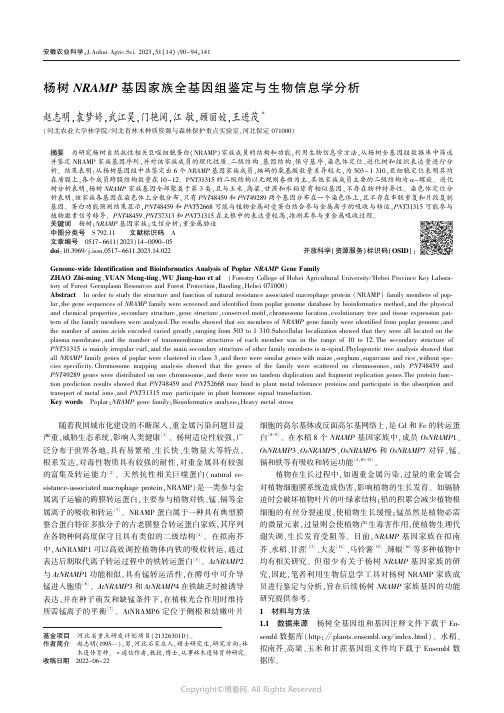
文章编号 0517-6611(2023)14-0090-05
doi:10.3969 / j.issn.0517-6611.2023.14.022
开放科学(资源服务)标识码(OSID):
Genome⁃wide Identification and Bioinformatics Analysis of Poplar NRAMP Gene Family
镉和铁等有吸收和转运功能[4,10-12] 。
植物在生长过程中,如遇重金属污染,过量的重金属会
sistance⁃associated macrophage protein,NRAMP)是一类参与金
对植物细胞膜系统造成伤害,影响植物的生长发育。 如镉胁
。 NRAMP 蛋白属于一种具有典型膜
细胞的有丝分裂速度,使植物生长缓慢;锰虽然是植物必需
摘要 为研究杨树自然抗性相关巨噬细胞蛋白(NRAMP)家族成员的结构和功能,利用生物信息学方法,从杨树全基因组数据库中筛选
并鉴定 NRAMP 家族基因序列,并对该家族成员的理化性质、二级结构、基因结构、保守基序、染色体定位、进化树和组织表达量进行分
析。 结果表明:从杨树基因组中共鉴定出 6 个 NRAMP 基因家族成员,编码的氨基酸数量差异较大,为 503 ~ 1 310,亚细胞定位表明其均
OsNRAMP3、OsNRAMP5、OsNRAMP6 和 OsNRAMP7 对锌、锰、
严重,威胁生态系统,影响人类健康
[1]
。 杨树适应性较强,广
根系发达,对毒性物质具有较强的耐性,对重金属具有较强
的富集及转运能力
[2]
。 天然抗性相关巨噬蛋白( natural re⁃
首个橡胶植物全基因组精细图绘制完成

备方法 . 中国发明专利号 :2 0 1 0 1 0 5 2 2 1 0 9 . 3 纳米 微 晶纤 维素 / 白炭 黑/ 橡胶 复合 材料 的 制备 方 法. 中国发明专利号 :2 0 1 0 1 0 5 2 2 1 2 芳 ,李雄辉 . 一种橡 胶/ 改性微 晶纤维素复合 材料及其 制备 方法 . 中国
《中 国橡 胶 网
她介绍 ,杜 仲具有其他任何高分子材料都 不具 备 的橡胶— — 塑料 二 重性 ,可 广 泛应 用于 军 事国防、航空航 天、交通、通讯、水利 、建筑 、 运动医学等领域。杜仲橡胶轮胎具有抗撕裂、耐 磨 、运动 阻力 小 的优 点, 油耗 可 以降低 2 . 5 % , 寿 命可 以提 高2 0 % 。1 吨杜仲 橡胶 轮胎 可 以减少 7 o 吨 汽油 消耗 ,被 国际社 会誉 为绿 色轮胎 。 但是,杜仲橡胶产业存在的主要 问题是,成 本比较高,每吨1 0 万元以上,杜仲各组织 中的橡 胶含量如果翻一倍,每 吨成本可以降低至5 — 6 万 元 。此次 基 因研 究, 首次 大量 鉴定 了杜 仲 橡胶 合 成相 关基 因;从基 因组 中发现 了7 o 个杜 仲 橡胶 合 成相关基 因,并进行了表达相关性的研究,首次
2 8
海内外动态 提出了杜仲橡胶合成的主要上游途径;首次大量 鉴 定 了杜仲 活性 成份相 关基 因。 乌 云塔娜 表示 ,此 次研 究成 果将对 突破 部分 高产杜仲橡胶技术,科学指导,都具有十分重要 的意 义 。杜仲 基 因组 测序 结束 了 ,这 是 良好 的开 端,下一步将着力解开杜仲的遗传密码。
发明专利号 :Z L 2 0 0 8 1 0 2 1 9 5 3 2 . 9 2 1 . 古 菊 ,贾德 民,谢 东 . 一 种橡 胶/ 改性
植物病毒载体系统的研究及应用

植物病毒载体系统的研究及应用作者:李成伟王来裴东丽王文静来源:《现代农业科技》2008年第15期摘要随着对植物病毒基因组结构的深入认识和病毒与植物之间相互作用分子机制的阐明,对植物病毒的遗传操作成为可能。
通过基因替代、插入融合、基因互补、抗原展示等方法构建的植物病毒载体系统在基础生物学研究领域和应用研究领域发挥着重大的作用。
对植物病毒系统载体构建策略及其应用进行综述,以期对研究者有所启发。
关键词植物病毒;载体构建;外源基因中图分类号 S188 文献标识码A文章编号1007-5739(2008)15-0132-04自1892年发现第1个植物病毒——烟草花叶病毒(tobacco mosaic virus,TMV)以来,目前世界植物病毒的种类已达909种。
科学家对植物病毒以及病毒和宿主之间的相互作用进行了深入地研究,对病毒基因组序列和调控机制的认识,使科学家在20世纪80年代初期提出利用植物病毒构建载体制作生物反应器,使外源蛋白、疫苗、药物等在植物体内的表达获得极大成功,现今已有多个植物表达载体系统构建成功。
随着模式植物拟南芥(Arabidopsis thaliana)、水稻、苜蓿、杨树等植物基因组序列测定的完成和更多的正在进行的植物基因组测序计划的完成,科学家们正面对大量未知功能的基因信息,现代生物学研究已进入到后基因组时代,即进行生物信息学、结构和功能基因组学、蛋白质组学研究等。
如何研究如此多基因的功能是生物学家所面对的主要问题,转录后基因沉默(post-transcriptional gene silencing, PTGS)的发现,为研究特定基因的功能提供了一个方向。
尤其是携带有内源性功能基因cDNA的植物病毒载体引起宿主内源性基因沉默,因其高效率和操作简单等优点在研究植物功能基因组学的过程中发挥举足轻重的作用。
1植物病毒载体系统的构建载体的构建一般选择基因组为DNA的病毒,但自然界中的植物病毒多为RNA病毒,少有DNA病毒,并且DNA病毒复制过程的复杂性使这种病毒不适于构建植物病毒载体[1]。
杨树HDZIP基因家族全基因组研究

573-581.[2]URUO T,YAMAGUCHI-SHINOZAKI K,URAO S,SHINOZAKI K..An Arabidopsis MYB homolog is induced by dehydration stress and its gene product binds to the conserved MYB recognition sequence[J].Plant Cell,1993,5(11):1529-1539.[3]JUNG C,SEO JS,HAN SW,KOO YJ,KIM CH,SONG SI,NALLNL BH,CHOI YD,CHEONG JJ,Overexpression of AtMYB44 Enhances Stomatal Closure to Confer Abiotic Stress Tolerance in Transgenic Arabidopsis[J].Plant Physiol,2008,146:623-635.[4] DAI XY,XU YY,MA QB,XU WY,Wang T,XUE YB,CHONG K.Overexpression of a R1R2R3MYB gene,OsMYB3R2,increases tolerance to freezing, drought, and salt stress in transgenic Arabidopsis[J].Plant Physiol,2007,143:1739-1751.[5] PAZ-ARES J,GHOSAL D,WIENAND U,et al.The regulatory c1 locus of Zea mays encodes a protein with homology to myb proto-oncogene products and with structural similarities to transcriptional activators [J].The EMBO Journal,1987(12):3553-3558.杨树HD-ZIP基因家族全基因组研究作者:陈雪指导教师:项艳(安徽农业大学林学与园林学院,安徽合肥230036)摘要:同源异型-亮氨酸拉链(HD-ZIP)蛋白是植物所特有的一类转录因子,类属于同源异型盒蛋白家族,它包含一个高度保守的同源异型结构域(HD),HD羧基末端紧连接着一个亮氨酸拉链(LZ)结构域。
林木分子育种瞄准高精尖

林木分子育种瞄准高精尖作者:铁铮延晓康李呈澄来源:《绿色中国·B》2020年第07期有关部门日前发布公告称,北京林木分子育种高精尖创新中心选育的4个杨树、梅花新品种通过刚刚国家林木良种审定,成为国家级良种家族的新成员。
它们分别是北林5号杨和燕杏、花蝴蝶、送春等3个抗寒梅花品种。
连同正在大力推广的北林雄株1号和北林雄株2号杨树、优良鲜食枣品种京沧1号,该中心成立3年来已选育出了7个国家林木良种,涵盖用材林、经济林、观赏植物等主要类别品种。
专家说,所谓的林木良种,其标准是通过权威部门审定、多个性状显著优于原有品种。
国家法律规定主要林木在品种推广应用前,均应通过国家级或省级审定。
国家良种代表了相关树种国内良种选育的先进水平。
据康向阳教授介绍,杨树是我国重要造林树种,年采伐量占国产木材年产量的18%以上。
最新通过审定的北林5号杨具有干型通直、材积生长量大、纤维长、纤维素含量高、木质素含量低等特点,是优良的短周期纸浆材等纤维用材品种。
依托速生优质国家良种建设的杨树速生丰产林,对缓解我国木材进口压力、减少天然林采伐、保护生态环境意义重大。
梅花位列中国十大传统名花之首。
张启翔教授团队选育的燕杏梅和花蝴蝶梅,在杏和梅的培育基础上,利用先进技术手段定向改变和组合植物本身基因的表达,集成了梅花和杏花的优点,综合了优良的遗传性状。
从天然杂种中选育出送春梅,可耐受-30℃的低温,填补了抗寒品种的空白,可在北京、内蒙古、新疆、辽宁、吉林等地区栽培,丰富了北方地区城市园林早春开花植物种类,对于提升城乡人居环境质量具有重要意义。
鲜枣是我国常见和群众最喜爱的经济林产品。
京沧1号枣具有较大的果型和甜酸适口的品质等特点,在高端鲜食枣市场极具开发潜力。
与普通冬枣相比,其成熟期早15天以上,对占领早期冬枣市场极具优势。
目前已在北京、河北、山东等地推广,对于京津冀和华北地区鲜枣生产起到了重要的推动作用。
据悉,中心构建了一批立足北京、服务京津冀、辐射全国的分子设计育种试验示范、成果转化、推广基地,促进从分子设计到林木新品种产业化应用的全链条提升。
我国率先完成枣树全基因组测序
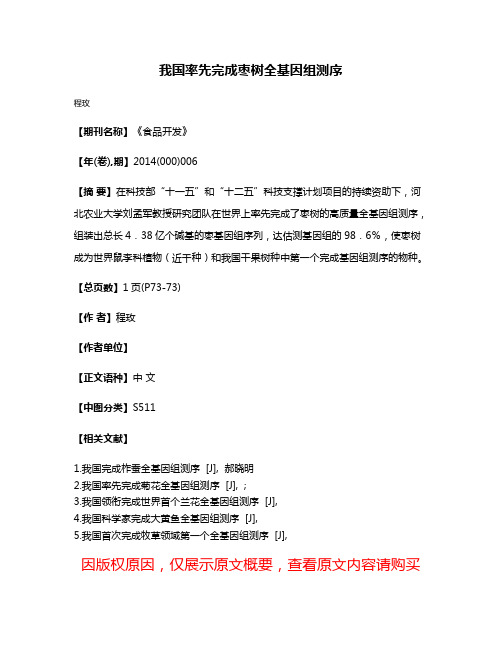
我国率先完成枣树全基因组测序
程玫
【期刊名称】《食品开发》
【年(卷),期】2014(000)006
【摘要】在科技部“十一五”和“十二五”科技支撑计划项目的持续资助下,河北农业大学刘孟军教授研究团队在世界上率先完成了枣树的高质量全基因组测序,组装出总长4.38亿个碱基的枣基因组序列,达估测基因组的98.6%,使枣树成为世界鼠李科植物(近千种)和我国干果树种中第一个完成基因组测序的物种。
【总页数】1页(P73-73)
【作者】程玫
【作者单位】
【正文语种】中文
【中图分类】S511
【相关文献】
1.我国完成柞蚕全基因组测序 [J], 郝晓明
2.我国率先完成菊花全基因组测序 [J], ;
3.我国领衔完成世界首个兰花全基因组测序 [J],
4.我国科学家完成大黄鱼全基因组测序 [J],
5.我国首次完成牧草领域第一个全基因组测序 [J],
因版权原因,仅展示原文概要,查看原文内容请购买。
从杨树基因组表达谱芯片数据中挖掘树木生长发育规律的研究
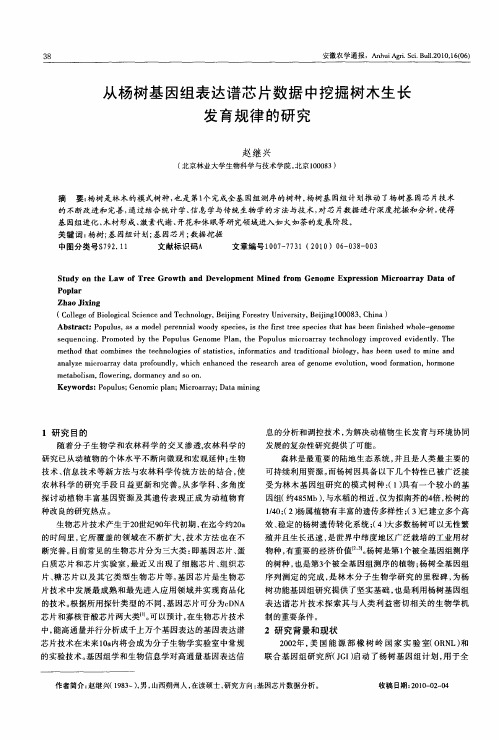
探讨 动植 物丰 富基 因资源 及其遗 传表 现正 成为 动植物 育
种改 良的研究热点 。
因组( 8M ) 约45 b , 与水稻 的相 近 , 仅为拟南芥 的4 , 倍 松树的 1 0( ) / ;2杨属植物 有丰富的遗传多样性 ;3) 4 ( 已建立多个高
效、 稳定 的杨树遗传转 化系统 ;4) 多数 杨树可 以无 性繁 ( 大
息 的分析 和调控技术 , 为解 决动植 物生长发 育与环境协 同 发展 的复杂性研究提供 了可能 。
森林 是最重 要的 陆地生态 系统 , 并且 是人类 最主要 的
可持续 利用 资源 。 而杨树 因具 备 以下 几个特性 已被广泛接 受 为林 木基 因组研 究 的模式 树种 : 1) 有一 个较小 的基 ( 具
关键 词: 杨树 ; 因组 计划; 因芯片; 基 基 数据挖掘 中图分类号¥ 9 . 1 7 2 1 文献标识码A 文章编号 1 0 — 7 1( )0 — 3 — 0 7 7 0 3 21 0 0 60 803
S ud n t w f Tr e Gr wt nd De e o t y o he La o e o h a v l pm e tM i e r m e o p e s o i r a r y Da a o n n d f o G n me Ex r s i n M c o r a t f
1研 究 目的
随着 分子 生物 学和农 林科 学 的交叉渗 透, 林科 学 的 农 研 究 已从动植 物 的个体水 平不 断向微观 和宏 观延伸 ; 生物 技术、 信息 技术 等新方 法与农 林科 学传 统方 法 的结合 , 使 农林 科 学的研 究手 段 日益更新 和完 善 。 从多 学科 、 角度 多
中国科学家完成花生全基因组测序属全球首次

年起 ,提高保额 、降低费率 、让利农户 ,提高农户 的风 险 保 障 水 平 ,即 2 0 1 2年 水 稻 制 种 保 险 每 6 6 7 m 保额 由原来 的 6 0 0元提高 到 8 0 0元 ,使种业 公 司及农民在种子试验、生产 中的经济损失得到合
理 补偿 。
的地点 、秋制 ( 烟后制)及遭遇台风或暴雨侵袭 的
2 0 1 3 年 第 6 期
琅 t 舛 妓
子 生产疫 情 防控 和病虫 防治带 来 一 定 的难 度 ,为 保
产 业效 益 ;三 是依 托种 子 管 理 站 、农 业 执法 、种 子 协 会 等多种 方 式进 行管 理 或行 业 自律 ,协 调 好 制种
隔离区、合理地规划生产 ,同时所有制种企业必须 与制种农户签订制种合 同,并使用统一的 《 制种合 同范本》 。
田块 及 时使用 噻 菌铜 预 防 ;五 是对 全 镇 早 、 中 、晚 杂交 水 稻制 种组 合 采 取 逐村 ( 行政村 ) 、逐 组 ( 村 民小 组 ) 、逐 片拉 网 式 产 地 检 疫 ,产 地 检 疫 面 积 占 镇域 内制 种 面积 6 0 % 以上 ;六 是抓好 水 稻制种 病 虫 害 防治 ,由于水稻 制种 ,母 本 是 接受 外 来 花 粉 ,且 近年 在 生 产 上 大 量 使 用 的 三 系 ( 中 九 A) 、两 系
法部门要加强对制种过程的监管 ,督促制种企业严 格履行合同和承诺 ,确保种业公 司能按质按价足额 收 购种 子 ,及 时兑现 农户 种 款 。对 制 种基 地 隔离 区 域 、隔离条件等达不到规定标准的 ,要责令制种企 业及 时 整改 ,整 改后 仍达 不 到 要求 的 ,终 止在 该 基
种业公 司负责人 、种子生产经纪人 、制种大户等参 加的培训班 4 期 、开展技术咨询 6 场次 ,印发宣传 资料 1 2 0 0 多份 ;二是严格产地检疫 申报制度 ,确 保镇域 内的种子生产所用亲本及制种面积百分百纳
林木遗传育种基础研究热点述评

sz ie,a d h g e e i o d,wh c k r e i c l t n p l t n g n t s su i s a d l a o t e p o r s f t e r n ih g n t la c i h ma e te s d f u t o ma i u a e i e e i t d e , n e d t h r g e s o h i i c
Ke wo d y r s:
F r s g n tc a d b e d n f n t n l g n mi s; a s c a i n a a y i ; wo d f r t n; oe t e eis n r e i g; u c i a e o c s o i to n l ss o o o ma i o
为林木 遗传 改 良进程 的 主要 限制 因素 。通过 基 因组
基 金 项 目 :林 业 公 益 性 行 业 科 研 专 项 ( 0 94 0 ;江 苏 省 高 校 自 然 科 学 基 金 重 点 项 目 ( 0 J 80 8) 2 00 0 2) 1 K AI0 1 ;国 家 自 然 科 学 基 金 项 目
第4 8卷 第 2期
20 12年 2 月
林
业
科
学
Vo . 1 48. .2 No
SCI ENTI A
S LVAE I
SI CAE NI
Fe b., 20 12
林 木 遗 传 育 种 基 础 研 究 热 点 述 评 : l =
万 志 兵
(.南 京林 业 大 学 1
பைடு நூலகம்
b s e ei s de a gn e idta fma yoh ri otn ra i .T ep o eerh b ssi temao a tr ai gn t t isl igb hn h to n te mp r togns c c u g a ms h o rrsac ai s h jrfco
基础科学研究的重大突破
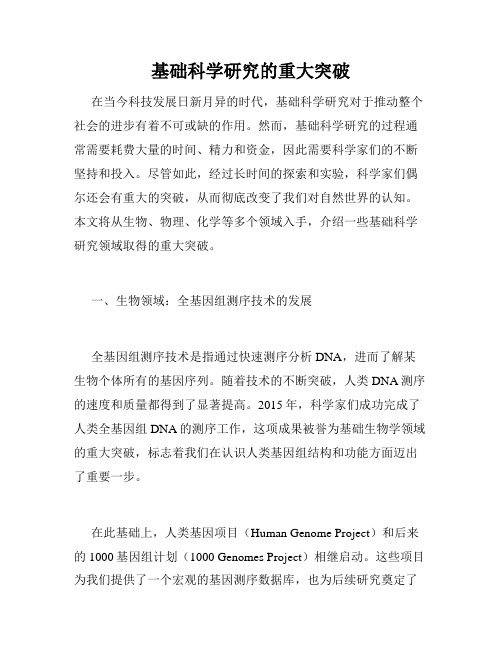
基础科学研究的重大突破在当今科技发展日新月异的时代,基础科学研究对于推动整个社会的进步有着不可或缺的作用。
然而,基础科学研究的过程通常需要耗费大量的时间、精力和资金,因此需要科学家们的不断坚持和投入。
尽管如此,经过长时间的探索和实验,科学家们偶尔还会有重大的突破,从而彻底改变了我们对自然世界的认知。
本文将从生物、物理、化学等多个领域入手,介绍一些基础科学研究领域取得的重大突破。
一、生物领域:全基因组测序技术的发展全基因组测序技术是指通过快速测序分析DNA,进而了解某生物个体所有的基因序列。
随着技术的不断突破,人类DNA测序的速度和质量都得到了显著提高。
2015年,科学家们成功完成了人类全基因组DNA的测序工作,这项成果被誉为基础生物学领域的重大突破,标志着我们在认识人类基因组结构和功能方面迈出了重要一步。
在此基础上,人类基因项目(Human Genome Project)和后来的1000基因组计划(1000 Genomes Project)相继启动。
这些项目为我们提供了一个宏观的基因测序数据库,也为后续研究奠定了基础。
全基因组测序技术的发展有力地推动了生命科学的发展,对于人类疾病的诊断、治疗以及预测显示了巨大的潜力。
二、物理领域:重力波的探测重力波是指在强磁场中形成的一种波动性质的物质的震动现象。
这种震荡可以通过引力的微小变化来传播,从而带有表征了体系大质量物体间强引力相互作用的信息。
然而,由于重力波其本身非常微弱,因此很难被探测。
但是,我们有幸于2015年口岸探测仪(LIGO)首次探测到了重力波,这项成果在物理学世界引起了极大的轰动。
探测到了重力波并不仅仅是一项技术的成果,它实际上也将物理学推向了一个全新的水平。
重力波的探测为我们提供了新的工具和方法去研究宇宙,对于弥补我们对于黑洞、中子星的知识空缺、研究宇宙的物理学、宇宙学等领域也开启了新的研究方向。
它的发现是具有极其重要意义的突破性进展,标志着物理学领域迎来了一个新的时代。
科学家测出杨树基因组草图
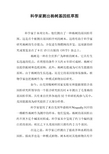
科学家测出杨树基因组草图科学家于本周宣布,他们测出了一种杨树的基因组草图。
这是首个被测出基因组序列的树木。
这将有助于科学家研究杨树的生存能力,并促进生物燃料的开发。
这项新的研究成果发表在了9月15日出版的《科学》杂志上。
杨树是一种在全世界广为种植的树木。
它具有生长迅速的优点,在理想的条件下大约4年即可成材。
杨树可以提供板材和造纸原料。
此外,杨树还能成为可再生能源的原料。
由于杨树的生长迅速,而且它的基因很容易操纵,植物学家也把杨树作为一种模式植物加以研究。
如今,由美国橡树岭国家实验室和能源部联合基因组研究所领导的一个联合研究组历时4年测出了毛果杨的基因组草图。
共有来自世界各地的32个科研机构参与其中,美国能源部为研究提供了大部分经费。
科学家使用了来自美国华盛顿州Nisqually河岸的一棵雌性杨树作为测序的样本。
他们发现,杨树的基因组由约不到5亿个碱基对组成。
科学家从中发现了约万个编码蛋白质的基因,相比之下人类基因组只拥有约2万个基因。
在这之前,科学家已经测出了拟南芥和水稻的基因组。
拟南芥也是一种模式植物。
树木相对其他植物具有许多其他植物不具备的特性,例如它会制造木质、寿命长,并且能适应环境的变化。
测定树木的基因组有助于科学家理解它的这些特性,选择杨树进行测序的原因还包括杨树的基因组相对较小,只有松树的1/40.通过与已测序的拟南芥基因组相比较,科学家发现杨树在历史上至少发生了3次基因组加倍的事件,其中一次发生在距今1亿到亿年前——而拟南芥和杨树的祖先大致也是在这个时候走上了不同的进化道路。
另一次加倍则发生在距今6000万年到6500万年之间。
基因组的加倍为杨树提供了多余的基因拷贝,从而有可能获得新的功能。
科学家还发现,杨树的进化速度似乎比拟南芥慢。
杨树的优异特性也让它有潜力成为一种生物燃料的原料。
杨树含有的木质素可以分解为糖。
糖经过发酵最终可以产生作为燃料的乙醇。
在一些国家,乙醇已经成为化石燃料的补充。
内含子多态性标记及其在烟草分子育种上的应用
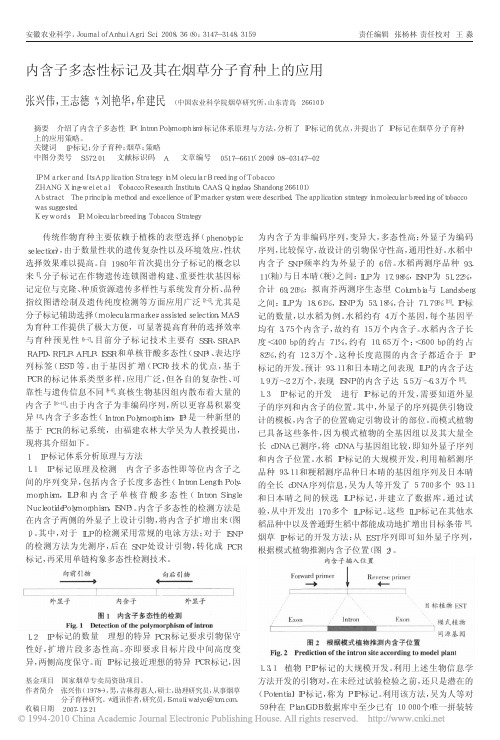
基金项目国家烟草专卖局资助项目。
作者简介张兴伟(1978-),男,吉林得惠人,硕士,助理研究员,从事烟草分子育种研究。
*通讯作者,研究员,E!mail:wzdycs@tom.com。
收稿日期2007!12!21传统作物育种主要依赖于植株的表型选择(phenotypicselection),由于数量性状的遗传复杂性以及环境效应,性状选择效果难以提高。
自1980年首次提出分子标记的概念以来[1],分子标记在作物遗传连锁图谱构建、重要性状基因标记定位与克隆、种质资源遗传多样性与系统发育分析、品种指纹图谱绘制及遗传纯度检测等方面应用广泛[2-5],尤其是分子标记辅助选择(molecularmarker!assistedselection,MAS)为育种工作提供了极大方便,可显著提高育种的选择效率与育种预见性[6-7]。
目前分子标记技术主要有SSR、SRAP、RAPD、RFLP、AFLP、ISSR和单核苷酸多态性(SNP)、表达序列标签(EST)等。
由于基因扩增(PCR)技术的优点,基于PCR的标记体系类型多样,应用广泛,但各自的复杂性、可靠性与遗传信息不同[8-9]。
真核生物基因组内散布着大量的内含子[10-11]。
由于内含子为非编码序列,所以更容易积累变异[12]。
内含子多态性(IntronPolymorphism,IP)是一种新型的基于PCR的标记系统,由福建农林大学吴为人教授提出,现将其介绍如下。
1IP标记体系分析原理与方法1.1IP标记原理及检测内含子多态性即等位内含子之间的序列变异,包括内含子长度多态性(IntronLengthPoly!morphism,ILP)和内含子单核苷酸多态性(IntronSingleNucleotidePolymorphism,ISNP)。
内含子多态性的检测方法是在内含子两侧的外显子上设计引物,将内含子扩增出来(图1)。
其中,对于ILP的检测采用常规的电泳方法;对于ISNP的检测方法为先测序,后在SNP处设计引物,转化成PCR标记,再采用单链构象多态性检测技术。
我国林木基因组学研究获突破:绘制完成毛白杨基因组序列框架图

我国林木基因组学研究获突破:绘制完成毛白杨基因组序列框
架图
佚名
【期刊名称】《科技与生活》
【年(卷),期】2011(0)14
【摘要】我国林木基因组学研究取得突破。
北京林业大学的科学家们选用百年古树作为测序的样本,利用最新的全基因组鸟枪法测序和拼接策略,绘制完成了毛白杨的基因组序列图谱,标志着毛白杨分子育种进入基因组时代。
【总页数】1页(P8-8)
【关键词】基因组学;白杨;序列;林木;框架图;北京林业大学;分子育种;科学家
【正文语种】中文
【中图分类】S792.11
【相关文献】
1.科学家绘制出毛白杨基因组序列框架图 [J],
2.毛白杨基因组序列框架图绘制完成 [J],
3.基因组领域又一重大科技突破--我国率先完成家蚕基因组序列“框架图“ [J], 摘自《光明日报》
4.基因组领域又一重大科技突破我国率先完成家蚕基因组序列“框架图” [J], 无
5.我国科学家绘制出毛白杨基因组序列框架图 [J],
因版权原因,仅展示原文概要,查看原文内容请购买。
树木转基因技术获得新突破

树木转基因技术获得新突破
佚名
【期刊名称】《《造纸信息》》
【年(卷),期】2005(000)007
【摘要】据报道,南京林业大学与北京林业大学等单位合作,通过转基因技术获得了抗病虫、抗旱耐盐和速生优质的转基因杨树等多个新树种。
6月23日,南林大和北林大共同承担的“国家转基因植物研究与产业化开发项目”通过了国家科技部专家组的验收。
【总页数】1页(P25)
【正文语种】中文
【中图分类】S188
【相关文献】
1.ABB联手国家电网,全球最大功率高压直流变压器技术获得新突破! [J],
2.树木转基因技术获得新突破 [J], ;
3.苎麻育苗技术获得新突破 [J], 刘志远;王真栋;
4.房屋抗震加固技术获得新突破 [J], 无;
5.我国石墨电极接头关键制备工艺技术获得新突破 [J],
因版权原因,仅展示原文概要,查看原文内容请购买。
南林大教授10年绘制杨树基因图谱

南林大教授10年绘制杨树基因图谱
张璐
【期刊名称】《农化市场十日讯》
【年(卷),期】2011(000)008
【摘要】南京林业大学教授尹佟明致力于解开中国林木基因的密码,2009年成功绘制出了杨树基因图谱,这也是我国首例“林木基因图谱”。
今年1月,尹佟明被评为“江苏省十大青年科技之星”。
【总页数】1页(P44-44)
【作者】张璐
【作者单位】不详
【正文语种】中文
【中图分类】S792.11
【相关文献】
1.忠实履行自己的职责——访中南林学院教授、博士生导师田大伦 [J], 戈亘
2.科学家完成非洲猪瘟基因图谱绘制 [J],
3.甘氨酸脱羧酶基因增强子区(-
4.2~-2.2 kb)基因图谱绘制及其活性检测 [J], 赵爽; 郑华川
4.甘氨酸脱羧酶基因增强子区(-4.2~-2.2 kb)基因图谱绘制及其活性检测 [J], 赵爽; 郑华川
5.无絮杨树南林场3412和南林3804在山东表现良好 [J],
因版权原因,仅展示原文概要,查看原文内容请购买。
- 1、下载文档前请自行甄别文档内容的完整性,平台不提供额外的编辑、内容补充、找答案等附加服务。
- 2、"仅部分预览"的文档,不可在线预览部分如存在完整性等问题,可反馈申请退款(可完整预览的文档不适用该条件!)。
- 3、如文档侵犯您的权益,请联系客服反馈,我们会尽快为您处理(人工客服工作时间:9:00-18:30)。
全球首次完成杨树全基因组测序由美国能源部启动并实施的杨树全基因组测序计划已圆满完成,并于2004年9月21日对公众开放了全序列数据库。
南京林业大学科研人员尹佟明副教授参与了此项研究。
杨树基因组的新闻发布及庆祝会定于12月6日在美国加州举行。
该项研究可望使杨树这一重要树种的品种改良时间大大缩短,用区区几十年跨越千年关。
研究的完成,使杨树成为继拟南芥和水稻之后,第三个测定全序列的植物,并且是第一个测定全基因组序列的多年生木本植物。
杨树因此被广泛接受为研究多年生植物基因组的模式物种,这使该项工作具有重大的科学意义。
杨树同时又是一种重要的工业用材树种,杨树全基因组计划实施,将为生物能源的开发提供知识贮备,具有重要的实际应用价值。
目前,杨树的改良还处在一种半野生的初级改良阶段,在基因组研究的基础上,通过群体和数量遗传学的手段在杨树属不同树种间开发有用等位基因,并通过遗传工程的手段进行基因重组,可望在几十年的时间里完成一般作物几千年的改良历程。
杨树全基因组全序列用“鸟枪法测定”,序列库中共含有7,649,993个序列片段,去除叶绿体基因组的污染,测得的序列大约为8×基因组长度。
目前对序列拼接的组装已完成了483Mb,占杨树基因组物理全长的90%以上,基本上覆盖了杨树基因组常染色体的大部分。
基于基因芯片和单核苷酸多态性检测技术,对小的序列拼接及序列间隙的填充工作正在进行中,预期这部分工作将于明年完成。
南京林业大学尹佟明副教授自2001年以来一直参与此项研究,对杨树基因组的注释工作将于今年12月初完成。
国际杨树基因组计划协作组的总负责人杰瑞先生认为,从世界范围来看,杨树在中国的林业生产中占有的比重是最大的,因此在杨树基因组信息的应用方面,中国在未来的研究中可能会居于世界前列。
杨树全基因组计划的完成对我国从事林业及生物技术的科学家而言,提供了前所未有的机遇和挑战。
Science 15 September 2006:Vol. 313. no. 5793, pp. 1596 - 1604DOI: 10.1126/science.1128691RESEARCH ARTICLESThe Genome of Black Cottonwood, Populus trichocarpa (Torr. & Gray)G. A. Tuskan,1,3* S. DiFazio,1,4S. Jansson,5J. Bohlmann,6I. Grigoriev,9U.Hellsten,9N. Putnam,9S. Ralph,6S. Rombauts,10 A. Salamov,9J. Schein,11L. Sterck,10 A. Aerts,9 R. R. Bhalerao,5 R. P. Bhalerao,12 D. Blaudez,13 W. Boerjan,10 A. Brun,13 A. Brunner,14 V. Busov,15 M. Campbell,16 J. Carlson,17 M. Chalot,13 J. Chapman,9 G.-L. Chen,2 D. Cooper,6 P. M. Coutinho,19 J. Couturier,13 S. Covert,20 Q. Cronk,7 R. Cunningham,1 J. Davis,22 S. Degroeve,10 A. Déjardin,23 C. dePamphilis,18 J. Detter,9 B. Dirks,24 I. Dubchak,9,25 S. Duplessis,13 J. Ehlting,7 B. Ellis,6 K. Gendler,26 D. Goodstein,9 M. Gribskov,27 J. Grimwood,28 A. Groover,29 L. Gunter,1 B. Hamberger,7 B. Heinze,30 Y. Helariutta,12,31,33 B. Henrissat,19 D. Holligan,21 R. Holt,11 W. Huang,9 N. Islam-Faridi,34 S. Jones,11 M. Jones-Rhoades,35 R. Jorgensen,26 C. Joshi,15 J. Kangasjärvi,32 J. Karlsson,5 C. Kelleher,6 R. Kirkpatrick,11 M. Kirst,22 A.Kohler,13 U. Kalluri,1 F. Larimer,2 J. Leebens-Mack,21 J.-C. Leplé,23 P. Locascio,2 Y. Lou,9 S. Lucas,9 F. Martin,13 B. Montanini,13 C. Napoli,26 D. R. Nelson,36 C. Nelson,37 K. Nieminen,31 O. Nilsson,12 V. Pereda,13 G. Peter,22 R. Philippe,6 G. Pilate,23 A. Poliakov,25 J. Razumovskaya,2 P. Richardson,9 C. Rinaldi,13 K. Ritland,8 P. Rouzé,10 D. Ryaboy,25 J. Schmutz,28 J. Schrader,38 B. Segerman,5 H. Shin,11 A. Siddiqui,11 F. Sterky,39 A. Terry,9 C.-J. Tsai,15 E. Uberbacher,2 P. Unneberg,39 J. Vahala,32 K. Wall,18 S. Wessler,21 G. Yang,21 T. Yin,1 C. Douglas,7M. Marra,11G. Sandberg,12Y. Van de Peer,10 D. Rokhsar9,24We report the draft genome of the black cottonwood tree, Populus trichocarpa. Integration of shotgun sequence assembly with genetic mapping enabled chromosome-scale reconstruction of the genome.More than 45,000 putative protein-coding genes were identified.Analysis of the assembled genome revealed a whole-genome duplication event; about 8000 pairs of duplicated genes from that event survived in the Populus genome. A second, older duplication event is indistinguishably coincident with the divergence of the Populus and Arabidopsis lineages. Nucleotide substitution,tandem gene duplication, and gross chromosomal rearrangement appear to proceed substantially more slowly in Populus than in Arabidopsis. Populus has more protein-coding genes than Arabidopsis, ranging on average from 1.4 to 1.6 putative Populus homologs for each Arabidopsis gene. However, the relative frequency of protein domains in the two genomes is similar. Overrepresented exceptions in Populus include genes associated with lignocellulosic wall biosynthesis, meristem development, disease resistance,and metabolite transport.1 Environmental Sciences Division, Oak Ridge National Laboratory, Oak Ridge, TN 37831, USA.2 Life Sciences Division, Oak Ridge National Laboratory, Oak Ridge, TN 37831, USA.3 Plant Sciences Department, University of Tennessee, TN 37996, USA.4 Department of Biology, West Virginia University, Morgantown, WV 26506, USA.5 Umeå Plant Science Centre, Department of Plant Physiology, Umeå University, SE-901 87, Umeå, Sweden.6 Michael Smith Laboratories, University of British Columbia, Vancouver, BC V6T 1Z4, Canada.7 Department of Botany, University of British Columbia, Vancouver, BC V6T 1Z4, Canada.8 Department of Forest Sciences, University of British Columbia, Vancouver, BC V6T 1Z4, Canada.9 U.S. Department of Energy, Joint Genome Institute, Walnut Creek, CA 94598, USA.10 Department of Plant Systems Biology, Flanders Interuniversity Institute for Biotechnology (VIB), Ghent University, B-9052 Ghent, Belgium.11 Genome Sciences Centre, 100-570 West 7th Avenue, Vancouver, BC V5Z 4S6, Canada.12 Umeå Plant Science Centre, Department of Forest Genetics and Plant Physiology, Swedish University of Agricultural Sciences, SE-901 83 Umeå, Sweden.13 Tree-Microbe Interactions Unit, Institut National de la Recherche Agronomique (INRA)–Université Henri Poincaré, INRA-Nancy, 54280 Champenoux, France.14 Department of Forestry, Virginia Polytechnic Institute and State University, Blacksburg, VA 24061, USA.15 Biotechnology Research Center, School of Forest Resources and Environmental Science, Michigan Technological University, Houghton, MI 49931, USA.16 Department of Cell and Systems Biology, University of Toronto, 25 Willcocks Street, Toronto, Ontario, M5S 3B2 Canada.17 School of Forest Resources and Huck Institutes of the Life Sciences, The Pennsylvania State University, University Park, PA 16802, USA.18 Department of Biology, Institute of Molecular Evolutionary Genetics, and Huck Institutes of Life Sciences, The Pennsylvania State University, University Park, PA 16802, USA.19 Architecture et Fonction des Macromolécules Biologiques, UMR6098, CNRS and Universities of Aix-Marseille I and II, case 932, 163 avenue de Luminy, 13288 Marseille, France.20 Warnell School of Forest Resources, University of Georgia, Athens, GA 30602, USA.21 Department of Plant Biology, University of Georgia, Athens, GA 30602, USA.22 School of Forest Resources and Conservation, Genetics Institute, and Plant Molecular and Cellular Biology Program, University of Florida, Gainesville, FL 32611, USA.23 INRA-Orléans, Unit of Forest Improvement, Genetics and Physiology, 45166 Olivet Cedex, France.24 Center for Integrative Genomics, University of California, Berkeley, CA 94720, USA.25 Genomics Division, Lawrence Berkeley National Laboratory, Berkeley, CA 94720, USA.26 Department of Plant Sciences, University of Arizona, Tucson, AZ 85721, USA.27 Department of Biological Sciences, Purdue University, West Lafayette, IN 47907, USA.28 The Stanford Human Genome Center and the Department of Genetics, Stanford University School of Medicine, Palo Alto, CA 94305, USA.29 Institute of Forest Genetics, United States Department of Agriculture, Forest Service, Davis, CA 95616, USA.30 Federal Research Centre for Forests, Hauptstrasse 7, A-1140 Vienna, Austria.31 Plant Molecular Biology Laboratory, Institute of Biotechnology, University of Helsinki,FI-00014 Helsinki, Finland.32 Department of Biological and Environmental Sciences, University of Helsinki, FI-00014 Helsinki, Finland.33 Department of Biology, 200014, University of Turku, FI-20014 Turku, Finland.34 Southern Institute of Forest Genetics, United States Department of Agriculture, Forest Service and Department of Forest Science, Texas A&M University, College Station, TX 77843, USA.35 Whitehead Institute for Biomedical Research and Department of Biology, Massachusetts Institute of Technology, Cambridge, MA 02142, USA.36 Department of Molecular Sciences and Center of Excellence in Genomics and Bioinformatics, University of Tennessee, Memphis, TN 38163, USA.37 Southern Institute of Forest Genetics, United States Department of Agriculture, Forest Service, Saucier, MS 39574, USA.38 Developmental Genetics, University of Tübingen, D-72076 Tübingen, Germany.39 Department of Biotechnology, KTH, AlbaNova University Center, SE-106 91 Stockholm, Sweden.These authors contributed equally to this work as second authors.These authors contributed equally to this work as senior authors.* To whom correspondence should be addressed. E-mail: gtk@。
